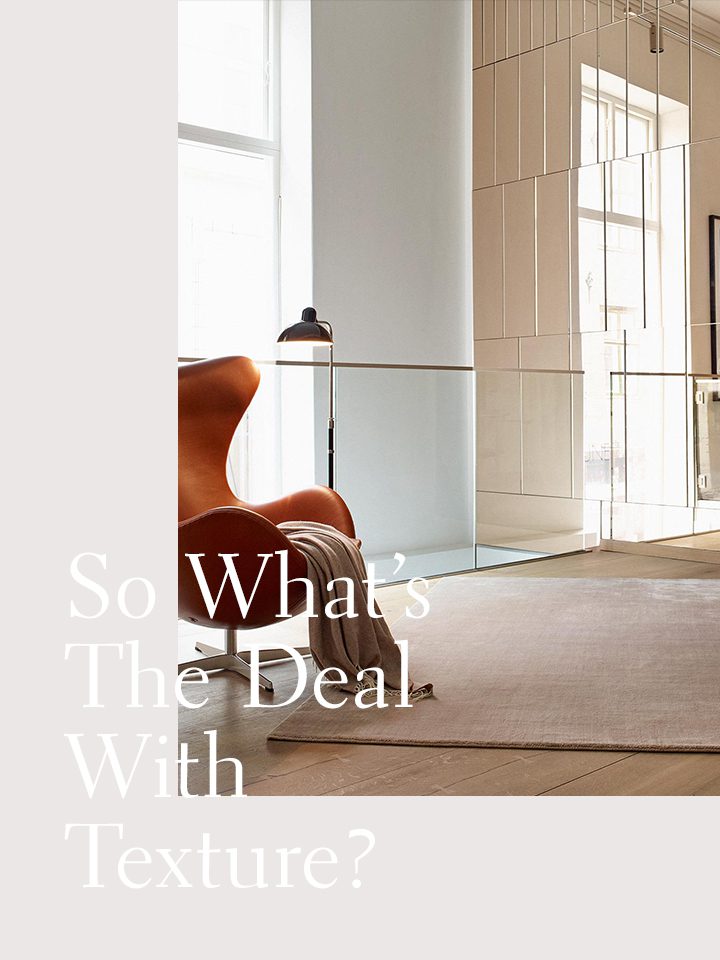The Good Design Journal
So, What’s The Deal With Texture?

We’ve all heard the buzzword thrown around, but what is meant by ‘texture’? It’s essentially a word referring to the idea of how something feels, its tactile representation, and its perception by our sense of sight. Basically we’re surrounded by texture, and, when implemented carefully and correctly, it can totally change the look and feel of a space.
We’re going to suss 5 points of texture to consider when bringing this element into your home.
1. Pattern and Print
Texture doesn’t have to be purely a tactile sensation, it can be perceived and created through our eyes. That feeling you get when you see pattern and print perfectly incorporated in a space, that’s the result of implied visual texture. It’s like our eyes are somehow able to touch and feel.
Bringing print and pattern into the home is a balancing act, and adding that little bit too much can become overwhelming and too much for our eyes to take in. Consider starting small – find a cushion, a throw rug, or a poster print and slowly grow from there. When playing the game of matching and pairing, remember this handy tip: soft organic shapes will often pair well with florals and other abstract pieces, whilst sharp geometric forms or busy patterns are best used against a neutral background.

2. All About The Materials
This is probably where your mind goes to immediately when hearing the word “texture”. And that’s totally fair. Composition and raw materials will often dictate the tactility of a product, which transfers over to its texture.
The material properties of a texture can also help dictate a room’s temperature. By temperature, we aren’t talking a measure of degrees, but more an idea… a bit like colour theory (warm and cool colours). Smooth textures, such as marble, steel, concrete, and leathers will often be cool to the touch. Strategic use of these materials help create a sense of calm and softness - perfect for bathrooms, powder rooms, and formal living spaces.
On the other hand bolder textures, like bumpy fabrics and high pile rugs, can be considered warmer. Your space will feel warm and cosy with the introduction of gutsy, rougher feeling pieces.
On the other hand bolder textures, like bumpy fabrics and high pile rugs, can be considered warmer. Your space will feel warm and cosy with the introduction of gutsy, rougher feeling pieces.

3. Some like it rough
Since we’re on the topic of rough, let’s talk about the grungy allure of a rough texture. It deserves special mention as we’re seeing a growing use of boucle fabrics, woven details, and rippled glass. These additions create points of interest, and add character to a space.
Don’t fret if you’re working on a smaller space, and don’t have the room to drop down a big piled rug, or the budget to blow on a boucle sofa. Think small, and introduce rough texture through ornamental objects, such as vases, cushions, and throws. Or hang a textural piece on the wall; think frames made of a unique material, or a woven wall hanging!

4. Get a little natural
Consulting the natural environment is a clever, and extremely affordable option when it comes to the game of texture. Greenery is an obvious choice, with plants offering a huge variety of texture, from smooth and glossy, to gnarly and coarse. Chuck them in a pot and bam, you’re done! Aside from plants, keep an eye out for other examples of natural and interesting textures. The beach is always a great spot for this; driftwood, rocks, and shells a-plenty!
5. Rugs
We’re giving rugs their own little section, because they really are a texture-category all to themselves. There’s an abundance of choice out there: shag, loop, hides, woven… You could even get clever and layer a few on top of each other for the ultimate burst of texture. Just remember to think practically. If it’s a high traffic area, look for something with a low pile (1.5cm or less), flat weave, or made of jute.


